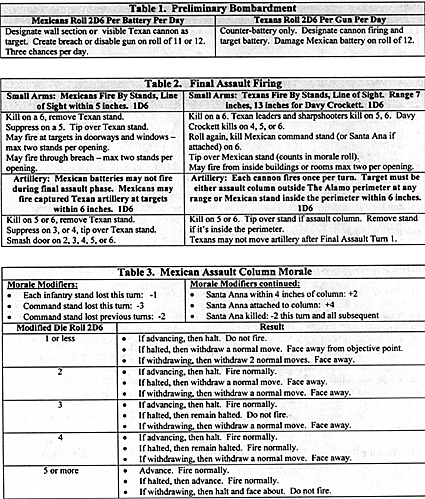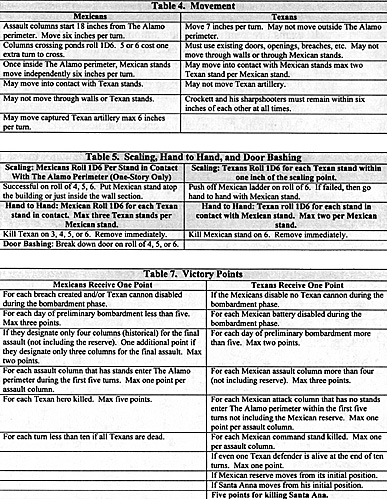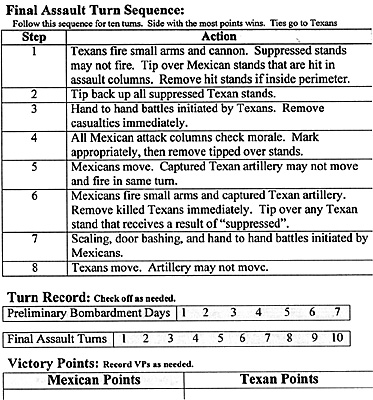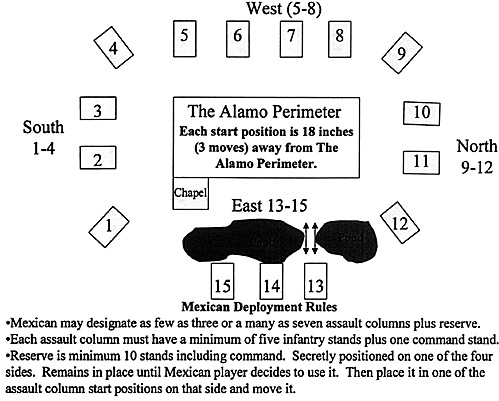*Please accept my apologies for the title. I do not mean to infringe upon any copyrighted material using the same name. These rules are for home use and not for resale purposes.
1. General. These rules are for a fast play of the Mexican attack on the Alarno, March 6, 1836. It's a beer and pretzels, "Big Six" game. Anybody who wants more may play Empire or WRG. At the end of ten turns, the side with the most points wins. Ties count as Texan victory.
Ground Scale: Inside The Alamo perimeter, one inch equals ten yards. Outside The Alamo perimeter, one inch equals twenty yards.
Man Scale: One Mexican stand equals about 20 soldiers. One Texan casting equals about 2.5 Alamo defenders.
2. The Game takes about two hours to play and accommodates up to five players to a side. It consists of two phases: preliminary bombardment, and final assault.
3. Preliminary Bombardment. The Mexicans have three artillery batteries that can attack the Alamo for up to seven days prior to the big assault. Historically, they did five days. On each day of bombardment, each battery attempts to create a breach in The Alamo perimeter or disable Texan artillery. Valid targets are wall sections or any visible Texan artillery. After designating a wall section or artillery piece as the target, the Mexican player rolls 2D6 for each battery each day. On a die roll of 11 or 12, the effect is either a breach or a Texan gun disabled. Breaches and disabled guns are permanent.
The Mexican player can continue this process for not more than seven days. Each day, he can designate new targets simulating re-deployment of his artillery during the night.
Texan artillery may attempt counter-battery fire. Each cannon that can be brought to bear upon a Mexican battery (range is unimportant, line of sight is all that counts) rolls 2D6 per day. A die roll of 12 damages the Mexican battery, that is, removes it from play for the rest of the game.
Counter-battery fire exposes Texan artillery to the possibility of Mexican fire. Otherwise, the Texan player may keep his artillery out of harm's way by placing it at ground level rather than up on the firing ramps. However, it takes one turn to move the guns up the ramps to firing positions once the assault begins. That means the Texan player who chooses to protect his guns loses a shot at the attacking columns on the first turn of the final assault phase.
Players may re-deploy batteries and guns once per day. For the Mexican, this simply means redesignating targets. For the Texan, it means moving guns from yesterday's position to today's and/or placing guns on the firing ramps for potential counter-battery fire or to repel assault.
4. Final Assault. The Mexican player has 80 stands of infantry and a number of command stands available for the final assault. He may organize them into as many as seven or as few as three attack columns (not including the reserve). Minimum number of stands per attack column is six (five infantry plus one command stand). Attack columns are two stands wide with a command stand as one of the two leading stands.
In addition, the Mexican player must designate a reserve column of not less that ten stands (nine infantry and one command). Historically, Santa Anna designated four assault columns (20, 19, 20, and 6 stands) and a reserve (19 stands).
Select a starting position for each of the assault columns and the reserve. There are 15 designated starting positions around The Alamo perimeter. Select one side of The Alamo (north, east, south, or west) for the reserve column. This is also Santa Anna's position.
The Texan player deploys all of his stands anywhere within The Alamo perimeter as follows:
- Crockett and his sharpshooters must stay together. That is, they may not be spread out as individuals all around the perimeter. Keep them all within a six inch span. Historically, they defended the barricade along the southeast perimeter near the chapel.
- Bowie begins and remains inside a room for the duration. He is immobile. Historically, he was in the easternmost room along the south wall.
- Travis, Bonham, and Dickinson may begin anywhere inside the Alamo perimeter. Travis was asleep and went to the north wall when the assault began. Dickinson was in the chapel.
- Artillery begins either up in firing positions ready to fire, or down inside the perimeter ready to be moved. Each cannon casting has one cannoneer casting.
5. Mexican Command Stands. Each assaulting column is led by a command stand that represents command and control during the column's move from its starting point to The Alamo perimeter. It moves and shoots just like any other infantry stand. If lost during the assault, the column subtracts from its morale roll. Once the assaulting column reaches The Alamo perimeter and no longer takes morale rolls, the command stand is removed and replaced by an infantry stand. There is no special use for command stands once the assault column has reached The Alamo perimeter. Texans get one point for each Mexican command stand they kill during the final assault phase.
6. Firing. Pay attention to the fact that small arms firing is not simultaneous. During the final assault phase, both the Texan and Mexican player may fire small arms and captured Texan artillery. The Mexican main batteries do not fire in the final assault phase. Firing is by line of sight. There are two target categories. Attack columns only exist outside The Alamo perimeter. Stands (Mexican and Texan) exist only inside the perimeter.
Crockett's Sharpshooters. Represent Davy Crockett and his band of sharpshooters. They have a greater probability to hit that the other Texans. Crockett adds two to his firing die roll and has a greater range. The rest of the sharpshooters add one to their firing die rolls.
Firing Rules: All stands and cannons may fire once per turn. Cannon may fire at attack columns within 45 degrees and line of sight at any range. Be liberal, but don't let either side fire artillery indiscriminately. No firing over friendly troops heads, etc.
- Texans may fire small arms at targets that are within seven inches and line of sight either inside or outside The Alamo perimeter.
- Davy Crockett, and Davy Crockett ONLY has an extended range and may fire at targets within 13 inches and line of sight.
- Mexican attack columns may fire two ranks deep at any targets within five inches and line of sight. Example: Attack column two stands wide, six stands deep is within five inches of a wall section where several Texans are defending. The Mexican player gets four shots - one for each of his front two rank stands.
- Mexican stands in contact with walls may fire at defenders above them. The assumption is that the defenders have to lean over to fire down, so the attackers get a chance to fire up. This is how Travis was killed according to one account.
- Attack column stands that have moved to the perimeter may fire through breaches. Maximum two stands per breach.
- Attack column stands at the barricade that connects the chapel and the south face may fire across the barricade.
- Attack column stands at the perimeter may fire up at Texans atop buildings or on firing steps and ramparts.
- Texans atop buildings or on firing steps and ramparts may fire small arms and artillery at attack columns that have reached the perimeter and are within range and line of sight.
- Texan artillery men may fire small arms or cannon, but not both in the same turn.
7. Movement. Mexican attack columns may move six inches per turn with all stands remaining touching. Once they reach The Alamo perimeter, Mexicans stands continue to move six inches per turn but no longer have to remain in contact with other stands. In other words, Mexican stands become independent once they reach the perimeter.
Mexican columns that begin on the eastern side of the table may be slowed in crossing the ponds between their starting positions and The Alamo perimeter. Roll I D6. On a roll of 5 or 6, the column becomes bogged and spends one extra turn crossing the pond. Note the presence of a road that crosses between the upper and lower ponds. An attack column may use that road to cross the ponds without making a die roll.
Attack columns remain two stands wide until the turn after reaching the perimeter. Then, as part of its movement each attacking column may extend its front by two stands per turn as part of the scaling process.
Texans may move up to seven inches per turn. Texans can move in any direction or combination of directions up to seven inches per turn. Texans can not move through walls or Mexican stands. Texans may move into contact with Mexican stands for the purpose of hand-to-hand fighting limit two Texan stands per Mexican stand. Texans may not move outside The Alamo perimeter.
Texans may not move their artillery during the final assault phase except to the top of the firing ramps to fire at Mexican assault columns. Mexicans may move captured Texan artillery a maximum of six inches per turn. It takes one Mexican stand to move and serve a captured artillery piece. The stand may not fire not participate in hand to hand fighting or door bashing while it serves the piece.
8. Breaching. Only Mexican artillery can create breaches as described in the bombardment section above. A breach is two Mexican stands wide allowing a maximum of two Mexican stand and/or four Texan stands to fire or fight hand to hand through. If undefended, any number of Mexican stands may move through as long as none violate movement limits or physical space restrictions.
9. Scaling. Each Mexican stand that is in frontal contact with The Alamo perimeter at the beginning of its movement segment may attempt to scale the perimeter wall in lieu of making normal movement. Exception. Only the one-story buildings and perimeter wall may be scaled. Roll one die per stand.
- The stand is successful on a die roll of 4, 5, or 6.
- If scaling point is undefended, then place the successful stand either atop the building or just inside the perimeter at the scaling point.
- If scaling point is defended, that is if there is at least one Texan stand within the width of the scaling Mexican stand, then allow the Texan to try to push off ladder. Roll one die. The Texan successfully pushes off the ladder on a die roll of 6. The Mexican may try agame next turn.
- If the Texan fails to push off the ladder, then the Mexican and Texan stands fight hand to hand in the following segment.
- Once a scaling attempt has been successful and the scaling point is no longer defended, place a ladder at the scaling point to mark it for other stands to use in subsequent turns. No further die rolls necessary unless a Texan stand moves to oppose. In that case, repeat process beginning with the Texan attempt to push off the ladder.
10. Hand to Hand. Hand to hand fighting is simultaneous and it's possible for both side to kill each other. Both sides roll for each stand in contact. Mexican stands may fight as many as three Texan stands per turn and kill them on a roll of 3, 4, 5, 6. As many as two Texan stands may fight one Mexican stand and kill it on a roll of 6.
Texan artillery men fight hand to hand just like the others.
Texans may take refuge inside buildings and rooms. If so, Mexicans may get them by breaking down the door using brute force or captured Texan cannons. Texans may shoot from windows max two shots per turn. Mexicans may shoot at Texans firing from windows.
11. Morale. Only Mexican attack columns make morale checks and they do so every turn, beginning with Turn 1, until they reach The Alamo perimeter (implies a minimum of three turns for those attack columns that begin moving on the first turn of final assault). Once columns reach the perimeter (have their lead stands in frontal contact with the walls), they no longer make morale checks. The key is crossing the distance from the assault column start point to The Alamo perimeter as quickly as possible. Once there, Mexican stands can begin scaling and hand to hand fighting and no longer need to make morale checks. One Mexican assault columns reach The Alamo perimeter; they begin to act independently in their attempts to scale the wall, fight hand-to-hand, and fire.
If forced to withdraw, assault columns do not leave the field, but remain at their starting point until they regame their morale - if ever.
12. Heroes. Heroes add one to all die rolls. Crockett adds two to his rifle fire die roll and has a greater rifle range than any other defender. Ideally, each Texan player should control one hero and an associated group of Texan defenders including a wall section, guns, canoneers, etc.
- Travis is the overall commander.
- Crockett commands his sharpshooters.
- Bonham.
- Dickinson
- Bowie. Immobile on his death bead. He may fire once and then he fights hand to hand normally.
Santa Ana is the lone Mexican hero. He begins the final assault phase with the Mexican reserve and may remain there during the entire final assault. He may choose to move and add his positive influence to the morale rolls of his assault columns. He may even attach himself to a column for a potentially greater benefit. If so, he may be subject to being killed by Texan fire. If Santa Ana is killed, the Texan player get five victory points, and all Mexican assault columns subtract two from all subsequent morale die rolls if any.
Santa Ana may move up to 24 inches per turn. If he attaches himself to an assault column, he moves at the same rate as the assault column until detaching himself from the column.
The Texan player receives one victory point if Santa Ana moves from his initial position.
13. The Mexican Reserve. The Mexican player must designate a reserve assault column of not less than ten stands. The Mexican player secretly identifies one of the four sides of The Alamo playing surface as the reserve position. The reserve remains off the table until the beginning of the turn in which it is committed to the fight. At that point, the Mexican player places the reserve in one of the assault column starting boxes on the pre-selected side of the playing surface. Then, it follows the process of moving toward The Alamo perimeter in the same way as the other assaulting columns. It may be subject to fire, takes morale checks, etc.
The Texan player receives one victory point if the Mexican reserve moves from its initial position.
14. Winning the Game. Each side receives points for certain decisions and achievements during the course of the game. The side with the most points after ten turns wins. Ties count as a Texan victory.
15. Designer's Note: Feel free to change, add, delete, ignore, or rob from these rules. I meant them for fun.
Charts (very slow: 431K)




Back to MWAN #100 Table of Contents
Back to MWAN List of Issues
Back to MagWeb Magazine List
© Copyright 1999 Hal Thinglum
This article appears in MagWeb (Magazine Web) on the Internet World Wide Web.
Other military history articles and gaming articles are available at http://www.magweb.com